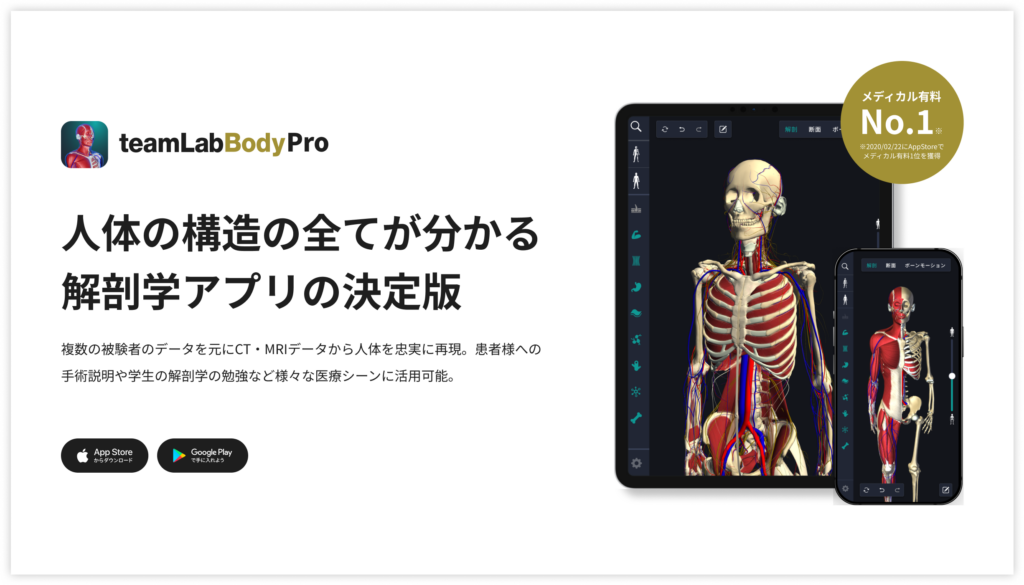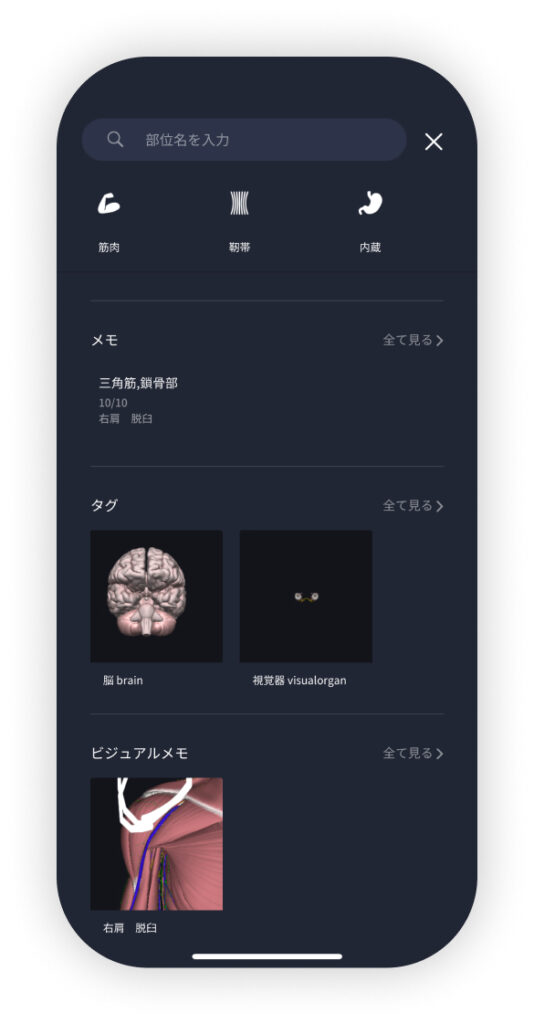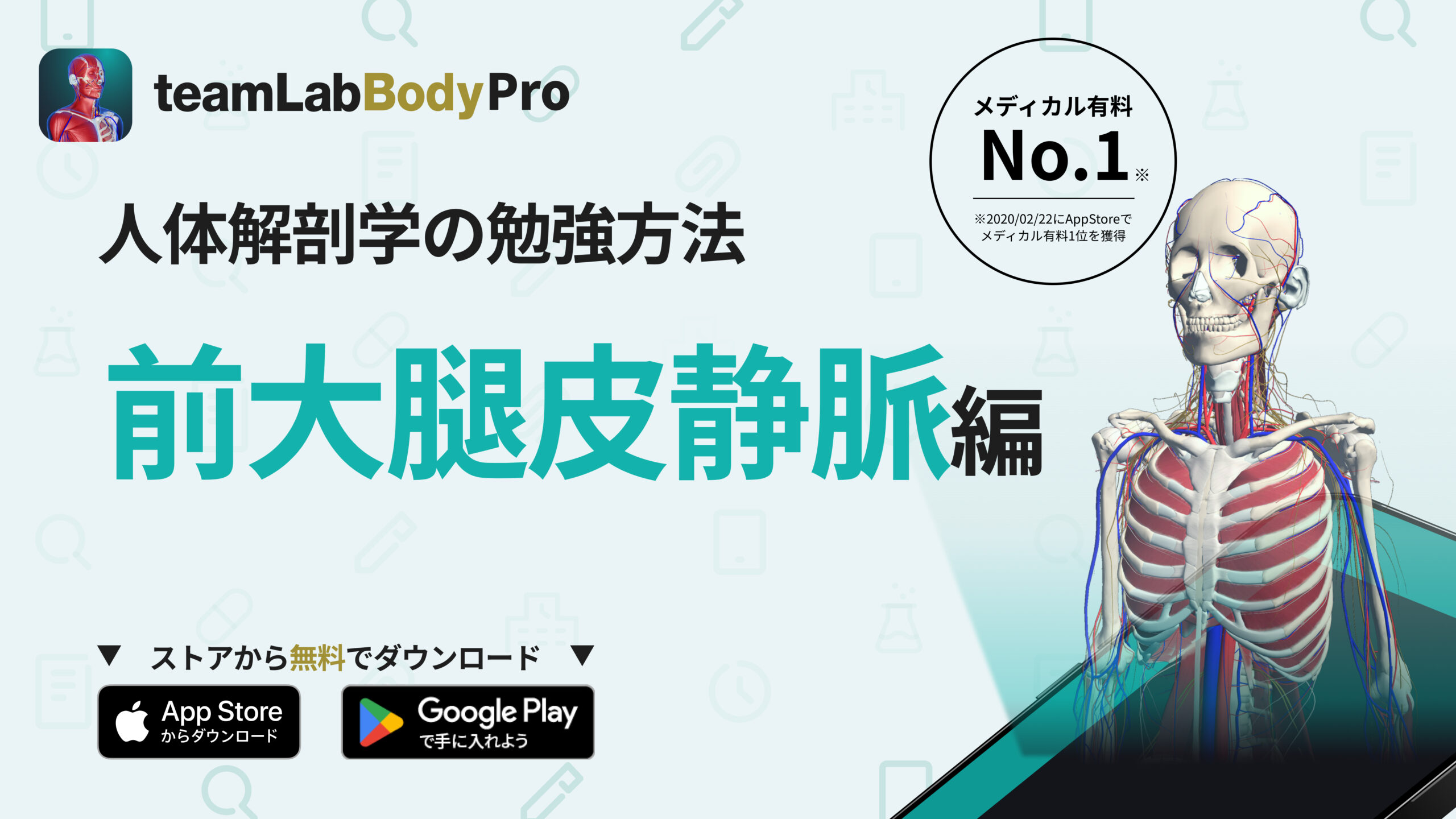beginning
In this article, I will explain effective study methods, starting with knowledge of specialized parts in human anatomy.
In human anatomy, it is necessary not only to memorize the names of various organs, muscles, and bones, but also to remember where they are located in the body. Therefore, it is necessary to learn as efficiently as possible.
I hope you can read this article and use the app to deepen your understanding even a little bit.
Now, I will explain the contents of the “anterior femoral vein” and how to study human anatomy.
teamLab Body Pro Free Download
A 3D anatomy app that shows all the structures of the human body
Download teamLab Body Pro here!

What is the anterior cutaneous femoral vein?
In the anatomy application, you can view a selection of anatomy 3D models. In this model, there are various observation methods such as surfaces, cross-sections, and nervous systems. This time, I'll explain using an anatomy application.
About anterior cutaneous femoral vein

The anterior femoral cutaneous vein (anterior femoral cutaneous vein) is one of the superficial veins running through the subcutaneous tissue at the front of the thigh. It collects blood from the skin and subcutaneous tissue of the thigh and merges into the femoral vein and large saphenous vein. Normally, it runs longitudinally on the front of the thigh and divides into multiple branches to collect a wide area of blood. There are individual differences in its running, but unlike deep blood vessels and nerves such as the femoral artery and femoral nerve, it is located in a layer shallower than fascia. This vein plays an important role in circulation in the surface layer of the thigh, and efficiently reflux from the skin. Anatomically, they may also have traffic branches with the deep venous system, and abnormalities in the superficial venous system may also affect deep veins. However, its main function is only to recover blood from the surface layer.
Study points
Location and structure of anterior cutaneous femoral vein
The anterior femoral cutaneous vein (anterior femoral cutaneous vein) is a superficial vein located in the subcutaneous tissue at the front of the thigh. It stretches across the front of the thigh and divides into many thin branches to collect blood from a wide area of skin and subcutaneous tissue. This vein is located in a layer shallower than the fascia, that is, just below the skin, and is clearly distinguished from major deep blood vessels and nerves (femoral artery, femoral nerve, etc.). Structurally, it is a relatively thin vein, and its confluence point is a larger superficial or deep venous system, such as the femoral vein or saphenous vein. There are large individual differences, and the number of branches and driving patterns are diverse. It may have transportation branches between the deep venous system.
The role and function of the anterior cutaneous femoral vein
The main role and function of the anterior femoral cutaneous vein (anterior femoral cutaneous vein) is to recover deoxygenated blood from the skin and subcutaneous tissue on the front of the thigh and return it to the larger venous system. This vein is located in the surface layer of the thigh and collects not blood from muscles or deep organs, but mainly blood containing waste products produced by metabolic activity in the skin. Its function is concentrated in smoothly performing venous reflux in the surface layer of the thigh. It is divided into many branches, collects blood from a wide subcutaneous capillary network, and eventually joins major veins such as the femoral vein and the large saphenous vein to maintain blood circulation to the heart.
English notation for anterior cutaneous femoral vein
The English notation for “anterior femoral cutaneous vein” is “anterior femoral cutaneous vein.” This name accurately describes its anatomical characteristics. “anterior” indicates the position of the front of the thigh, “femoral” indicates that it belongs to the thigh, “cutaneous” indicates that it is a cutaneous vein just below the skin, and “vein” is a vein, respectively. In this way, each word is combined to clearly express the location and type of blood vessels.
How to study human anatomy
I will explain specific study methods using human anatomy applications.
Check your past learning history and practice repeatedly
Here are the steps to check your anatomy learning history and practice iteratively effectively.
1. Check your learning history in the app
Reviewing your learning history with the application is an important step in effectively advancing anatomy learning. First, launch the app and go to the learning history section from the main menu. Many anatomy apps are designed to show your progress in the form of graphs and lists, so you can visually check which parts you've learned about and how much time you've spent.
By using this data, you can understand which areas you have strengths in and where you need to spend more time and effort. We also recommend using a dedicated tag or notebook function to mark areas you are particularly weak at or where you need to relearn. Regularly checking your learning history and looking back on past learning content will lead to efficient review and deepening understanding.
2.Make a plan for iterative learning
Making an efficient repetitive learning plan based on learning history is extremely effective in promoting knowledge retention. First, identify weak points and areas where you need to relearn. Next, arrange these study items into a weekly or monthly calendar and create a specific study schedule. By proceeding in a planned manner, you can learn each part evenly and avoid packing in a large amount of information at once.
Using a task management app or digital calendar to set study reminders is effective. Also, it's important to have the flexibility to regularly review progress and revise plans as needed. By having goals and proceeding with your studies in a planned manner, you can efficiently acquire anatomical knowledge.
3.Use 3D features to learn visually
By utilizing the 3D function, learning anatomy is easier to understand visually. The 3D model shows the structure of the human body three-dimensionally, and each part can be observed in detail. This makes it possible to intuitively grasp positional relationships between deep muscles and organs that are difficult to capture in a planar view. For example, you can learn even the smallest details by rotating specific muscles and bones and zooming in and out.
Also, there are many apps that have the function of displaying cross-sectional views of each part using a 3D model, which is useful for deepening understanding of internal structures. This diversity of visual information helps with memory retention and improves immediate responsiveness in tests and practice situations. By utilizing the 3D function and learning visually, you can learn anatomy knowledge more deeply and efficiently.
Use the memo function concretely

Make notes so you don't forget the things and points you've noticed while studying. The memo function can be used for different purposes, such as inputting text, saving images, and writing memos. Tag your notes to make them easier to review later.
Test your learning regularly in the form of quizzes
Regularly testing what you've learned in a quiz format is a very effective way to anchor your anatomy knowledge. Quiz-style tests help you objectively grasp your level of understanding and areas you lack while repeating knowledge.
For example, by using a learning app to conduct quizzes every specific period, you can reconfirm what you've learned and strengthen your memory. There are a wide range of quiz formats, such as multiple choice questions, fill-in-the-blank questions, and short answer questions, and each helps understanding from a different angle and develops the ability to utilize various types of knowledge.
Get feedback
If possible, get feedback from other learners and experts. It helps you find your own gaps in understanding and areas for improvement. You can also keep yourself motivated to learn by regularly testing yourself. Feeling a sense of accomplishment and progress increases motivation for continuous learning.
summary
This time, I explained how to study the “anterior femoral cutaneous vein” using an application!
Thank you for reading this far.
I would be happy if reading this article helped you learn about anatomy.
Learning is a long, never-ending journey, but I sincerely wish you all the best. Let's continue to study together and work hard for the national exam!
Please look forward to the next blog.




